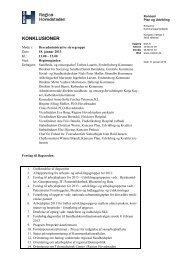Territorial Review Copenhagen - Region Hovedstaden
Territorial Review Copenhagen - Region Hovedstaden
Territorial Review Copenhagen - Region Hovedstaden
You also want an ePaper? Increase the reach of your titles
YUMPU automatically turns print PDFs into web optimized ePapers that Google loves.
226<br />
3.3.1 Fiscal equalisation<br />
Like many OECD countries that are strongly decentralised, Denmark<br />
has an equalisation scheme that compensates municipalities with a low tax<br />
base and high costs relative to the average municipality in Denmark. A<br />
municipality whose estimated expenditure is larger than its estimated tax<br />
receipts receives an equalisation subsidy, which is 58% of the difference<br />
between the expenditure and the estimated tax revenues. Conversely, if the<br />
receipts are higher than estimated expenditures, 58% of the difference has to<br />
be paid in equalisation contribution. Funding for the equalisation system,<br />
above the contribution stipulated, is provided by the central government.<br />
The estimation of revenues and expenditures is carried out by the Ministry<br />
of Welfare.<br />
The structural reform of 2007 had an impact on the equalisation scheme,<br />
raising the equalisation rate of the national scheme from 45% to 58%, while<br />
simultaneously lowering the rate of the <strong>Copenhagen</strong> scheme from 40% to<br />
27%. The reform also introduced a new equalisation scheme concerning<br />
municipal revenue from tax on limited liability companies. If revenue is<br />
higher than the national average, the relevant municipality has to pay 50%<br />
of the difference between the municipality‘s revenue per inhabitant and the<br />
national average to the municipalities where the opposite is the case. An<br />
additional rule was introduced with the purpose of increasing equalisation if<br />
the economic growth in <strong>Copenhagen</strong> outpaces the rest of the country. If the<br />
tax base per inhabitant growth rate in <strong>Copenhagen</strong> is higher than the rest of<br />
the country, the equalisation percentage in the general equalisation scheme<br />
is increased by one percentage point, calculated from the base year of<br />
2007In the opposite case, equalisation is not reduced. The general<br />
equalisation cannot increase to more than 68%.<br />
3.3.2 Sub-national fiscal autonomy<br />
Although Denmark has one of the highest degrees of sub-central<br />
government autonomy over tax rates in theory, fiscal autonomy is limited in<br />
practice. With the tax freeze for all government tiers implemented in 2002<br />
by the national government, there is an explicit limit on tax autonomy that<br />
means that the average local tax rate is not allowed to increase. This policy<br />
was made even stricter in 2005. In addition, implicit sanctions on subcentral<br />
governments serve to restrain increases in tax rates. Apart from the<br />
tax rate increases that were needed to finance the new functions of<br />
municipalities after the structural reform in 2007, the raises in tax rates in<br />
Denmark have been relatively moderate: only from 2003 to 2004 was there a<br />
significant increase in tax rates (see Figure 3.9). The average tax rate of

















